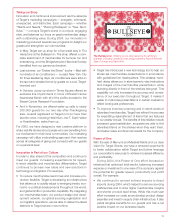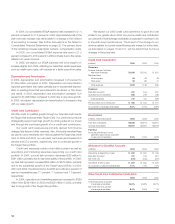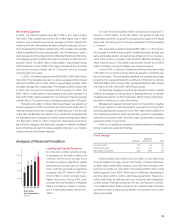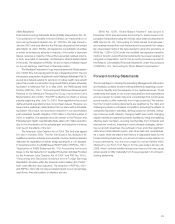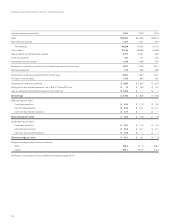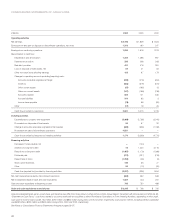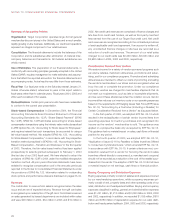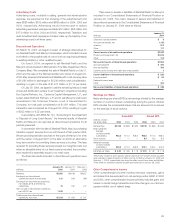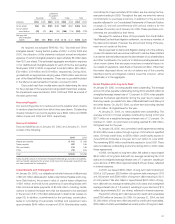Target 2004 Annual Report Download - page 23
Download and view the complete annual report
Please find page 23 of the 2004 Target annual report below. You can navigate through the pages in the report by either clicking on the pages listed below, or by using the keyword search tool below to find specific information within the annual report.
21
Market Risk
Our exposure to market risk results primarily from changes in interest
rates on our debt obligations, as well as the effect of market returns
on our non-qualified defined contribution and qualified defined benefit
pension plans. We hold derivative instruments primarily to manage
our exposure to these risks, and all derivative instruments are matched
against specific debt obligations or other liabilities. There have been
no material changes in the primary risk exposures or management
of the risks since the prior year. See further discussions in the Notes
to Consolidated Financial Statements on pages 31-36.
The annualized effect of a one percentage point increase in
floating interest rates on our interest rate swap agreements and other
floating-rate debt obligations, net of floating-rate cash equivalents,
at January 29, 2005 would be to increase interest expense by
approximately $19 million. The annualized effect of a one percentage
point change in equity market returns on our non-qualified defined
contribution plans (inclusive of the effect of derivative instruments
used to hedge or manage these exposures) would not be significant.
The annualized effect of a one percentage point decrease in the
return on pension plan assets would be to decrease plan assets by
$17 million. The resulting impact on net pension expense would be
determined consistent with the provisions of SFAS No. 87, “Employers’
Accounting for Pensions.” In 2005, the majority of our credit card
receivables will be assessed finance charges at a prime-based floating
rate instead of a fixed rate. The impact of this change to our revenue
will be determined by future changes in the prime rate. In order to
protect our credit card economics in light of future changes in the
prime rate, we plan to maintain a sufficient level of floating-rate debt
to achieve parallel changes in our finance charge revenue and
interest expense.
Analysis of Discontinued Operations
In 2004, revenues and earnings from discontinued operations were
lower than prior years due to only a partial year of results, which
excluded the holiday season.
The financial results included in discontinued operations were
as follows:
January 29, January 31, February 1,
(millions) 2005 2004 2003
Revenue $3,095 $6,138 $6,507
Earnings from discontinued
operations before income taxes 121 306 399
Earnings from discontinued operations,
net of $46, $116 and $152 tax,
respectively 75 190 247
Gain on sale of discontinued operations,
net of $761 tax 1,238 ——
Total income from discontinued
operations, net of tax $1,313 $ 190 $ 247
Critical Accounting Estimates
Our analysis of operations and financial condition is based upon our
consolidated financial statements, which have been prepared in
accordance with accounting principles generally accepted in the
United States. The preparation of these financial statements requires
us to make estimates and assumptions that affect the reported
amounts of assets and liabilities at the date of the financial statements,
the reported amounts of revenues and expenses during the reporting
period and the related disclosures of contingent assets and liabilities.
In the Notes to Consolidated Financial Statements, we describe our
significant accounting policies used in preparation of the consolidated
financial statements. We evaluate our estimates on an ongoing basis.
We base our estimates on historical experience and on other assump-
tions that we believe to be reasonable under the circumstances.
Actual results could differ from these estimates under different
assumptions or conditions.
The following items in our consolidated financial statements
require significant estimation or judgment:
Inventory and cost of sales We account for substantially all of our
inventory and the related cost of sales under the retail inventory
method. Under the retail inventory method, inventory is stated at cost,
which is determined by applying a cost-to-retail ratio to each mer-
chandise grouping’s ending retail value. Since this inventory value
is adjusted regularly to reflect market conditions, our inventory
methodology reflects the lower of cost or market. We reduce inventory
for estimated losses related to shortage and markdowns. Shortage
is based upon historical losses verified by prior physical inventory
counts. Markdowns designated for clearance activity are recorded
when the salability of the merchandise has diminished. Inventory is
at risk of obsolescence if economic conditions change, such as
shifting consumer demand, changing consumer credit markets, or
increasing competition. These risks are mitigated because substantially
all of our inventory sells in less than six months. Inventory is described
in the Notes to Consolidated Financial Statements on page 30.
Vendor income receivable Cost of sales is partially offset by various
forms of consideration earned from our vendors. We receive income for
a variety of vendor-sponsored programs such as volume rebates,
markdown allowances, promotions and advertising, and for our com-
pliance programs. We establish a receivable for the vendor income
that is earned but not yet received from our vendors. This receivable is
based on provisions of the programs in place, and is computed by
estimating the point at which we’ve completed our performance under
the agreement and the amount is earned. Due to the complexity and
diversity of the individual agreements with vendors, we perform detailed
analyses and review historical trends to determine an appropriate level
of the receivable in aggregate. See further discussions in the Notes to
Consolidated Financial Statements on page 28.




